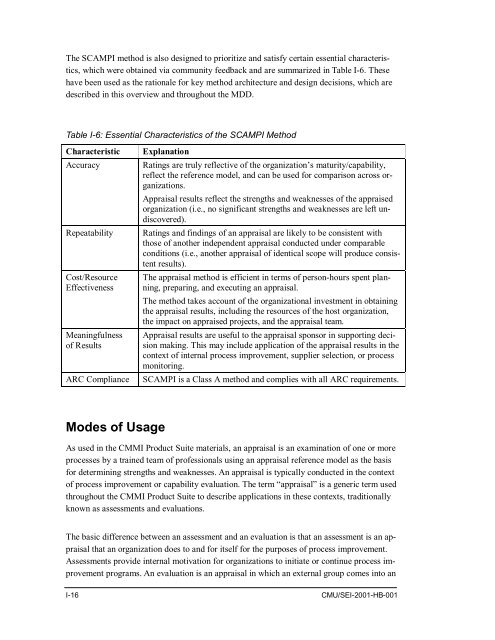Standard CMMI Appraisal Method for Process Improvement (SCAMPI)
Standard CMMI Appraisal Method for Process Improvement (SCAMPI)
Standard CMMI Appraisal Method for Process Improvement (SCAMPI)
Create successful ePaper yourself
Turn your PDF publications into a flip-book with our unique Google optimized e-Paper software.
The <strong>SCAMPI</strong> method is also designed to prioritize and satisfy certain essential characteristics,<br />
which were obtained via community feedback and are summarized in Table I-6. These<br />
have been used as the rationale <strong>for</strong> key method architecture and design decisions, which are<br />
described in this overview and throughout the MDD.<br />
Table I-6: Essential Characteristics of the <strong>SCAMPI</strong> <strong>Method</strong><br />
Characteristic<br />
Accuracy<br />
Repeatability<br />
Cost/Resource<br />
Effectiveness<br />
Meaningfulness<br />
of Results<br />
ARC Compliance<br />
Explanation<br />
Ratings are truly reflective of the organization’s maturity/capability,<br />
reflect the reference model, and can be used <strong>for</strong> comparison across organizations.<br />
<strong>Appraisal</strong> results reflect the strengths and weaknesses of the appraised<br />
organization (i.e., no significant strengths and weaknesses are left undiscovered).<br />
Ratings and findings of an appraisal are likely to be consistent with<br />
those of another independent appraisal conducted under comparable<br />
conditions (i.e., another appraisal of identical scope will produce consistent<br />
results).<br />
The appraisal method is efficient in terms of person-hours spent planning,<br />
preparing, and executing an appraisal.<br />
The method takes account of the organizational investment in obtaining<br />
the appraisal results, including the resources of the host organization,<br />
the impact on appraised projects, and the appraisal team.<br />
<strong>Appraisal</strong> results are useful to the appraisal sponsor in supporting decision<br />
making. This may include application of the appraisal results in the<br />
context of internal process improvement, supplier selection, or process<br />
monitoring.<br />
<strong>SCAMPI</strong> is a Class A method and complies with all ARC requirements.<br />
Modes of Usage<br />
As used in the <strong>CMMI</strong> Product Suite materials, an appraisal is an examination of one or more<br />
processes by a trained team of professionals using an appraisal reference model as the basis<br />
<strong>for</strong> determining strengths and weaknesses. An appraisal is typically conducted in the context<br />
of process improvement or capability evaluation. The term “appraisal” is a generic term used<br />
throughout the <strong>CMMI</strong> Product Suite to describe applications in these contexts, traditionally<br />
known as assessments and evaluations.<br />
The basic difference between an assessment and an evaluation is that an assessment is an appraisal<br />
that an organization does to and <strong>for</strong> itself <strong>for</strong> the purposes of process improvement.<br />
Assessments provide internal motivation <strong>for</strong> organizations to initiate or continue process improvement<br />
programs. An evaluation is an appraisal in which an external group comes into an<br />
I-16 CMU/SEI-2001-HB-001
















